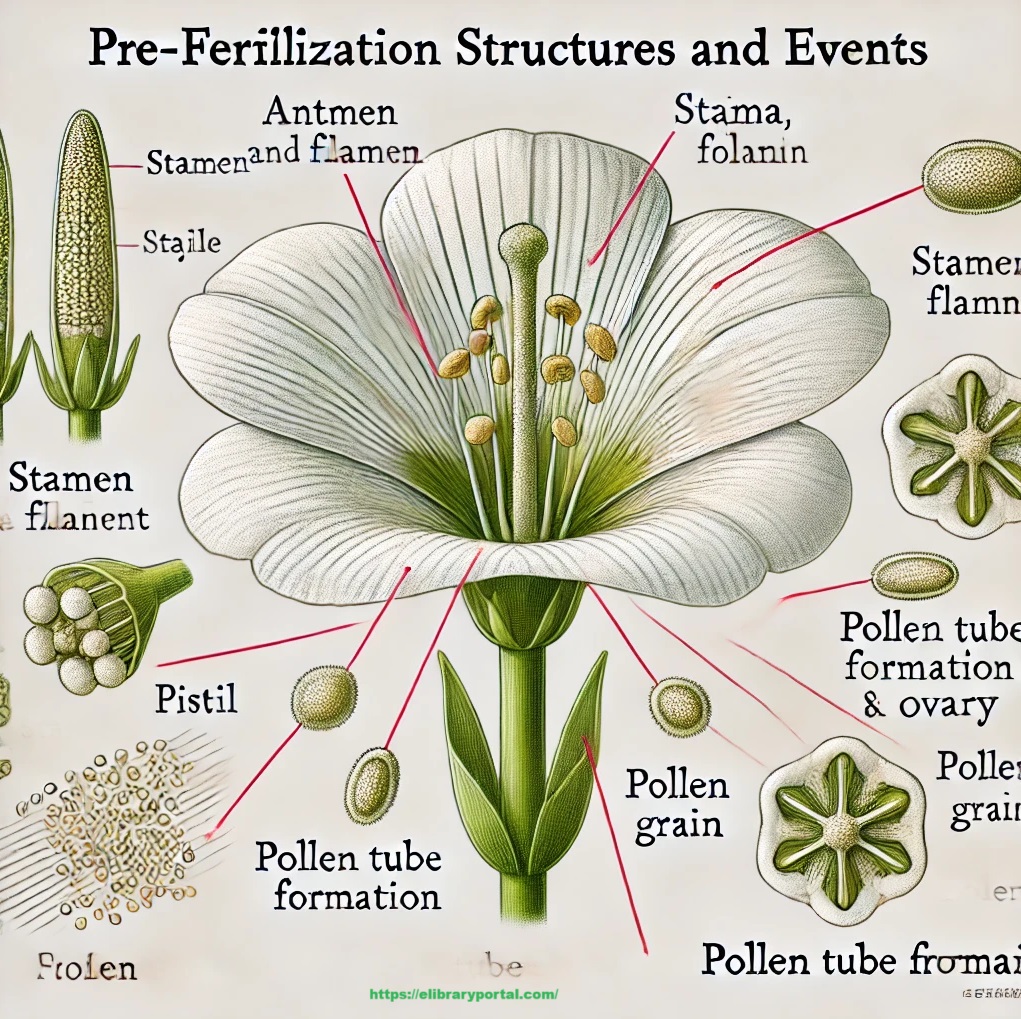In flowering plants, fertilization refers to the process where the male and female gametes unite to form a new seed. However, before fertilization can occur, several important structures must develop, and specific events must take place. These pre-fertilization stages are essential to ensure successful reproduction. Let’s break it down into simple terms, and I’ll include an illustration to help explain these concepts.
1. Pre-Fertilization Structures
Before fertilization, a flower develops certain reproductive structures:
- Stamen (Male Part): The stamen is made up of two parts:
- Anther: The part that produces and stores pollen grains (which contain the male gametes).
- Filament: The stalk that holds up the anther.
- Pistil (Female Part): The pistil is made up of three parts:
- Stigma: The sticky top part where pollen grains land during pollination.
- Style: A tube-like structure that connects the stigma to the ovary.
- Ovary: The part that contains the ovules (which house the female gametes).
2. Events Leading to Fertilization
Several steps take place before the actual process of fertilization happens:
- Pollination: This is the transfer of pollen from the anther (male part) to the stigma (female part). Pollination can happen in different ways, like by wind, insects, or animals. When a pollen grain lands on the stigma, it begins the journey toward fertilization.
- Pollen Germination: Once a pollen grain reaches the stigma, it germinates, meaning it starts growing a tube. This tube is called the pollen tube, and it extends down through the style toward the ovary. The tube carries the male gametes (sperm cells) to the ovules in the ovary.
- Pollen Tube Growth: The pollen tube continues to grow toward the ovules, ensuring that the male gametes can reach the female gametes. This step is crucial because without the pollen tube, fertilization cannot happen.
These structures and events ensure that the male gametes can travel to the ovule to complete the process of fertilization.
See in Fig.

Here is the diagram illustrating the pre-fertilization structures and events in a flower, showing key parts such as the stamen, pistil, and the process of pollen tube growth
10 Questions and Answers based on the topic “Pre-Fertilization: Structures and Events in Flowering Plants”
1. What is meant by pre-fertilization in flowering plants?
Answer:
Pre-fertilization refers to all the events and processes that happen before the actual fertilization, where the male and female gametes (sperm and egg) unite. This includes the development of reproductive structures like the stamen and pistil and the process of pollination and pollen tube formation.
2. What are the main reproductive structures involved in pre-fertilization?
Answer:
The main reproductive structures in flowers are:
- Stamen (male part): Composed of the anther (produces pollen) and filament (supports the anther).
- Pistil (female part): Composed of the stigma (receives pollen), style (connects stigma to ovary), and ovary (contains ovules).
3. What is pollination, and why is it important?
Answer:
Pollination is the transfer of pollen from the male part (anther) of a flower to the female part (stigma). It’s important because it allows the male gametes (in the pollen) to reach the female gametes (in the ovules), which is necessary for fertilization to occur.
4. How does pollen reach the ovary?
Answer:
After pollination, the pollen grain lands on the stigma. It then germinates and grows a pollen tube down through the style, heading toward the ovary. This tube carries the male gametes (sperm cells) to the ovule inside the ovary.
5. What is the role of the stigma in pre-fertilization?
Answer:
The stigma is the top part of the pistil, and its role is to capture pollen grains during pollination. It is often sticky or feathery, which helps in trapping pollen from the air or pollinators like insects.
6. What is the anther, and what does it do?
Answer:
The anther is the part of the stamen (male part of the flower) that produces pollen. Pollen grains contain the male gametes needed for fertilization. The anther releases pollen when the flower is ready for pollination.
7. What is the function of the pollen tube?
Answer:
The pollen tube functions as a passageway for the sperm cells. After a pollen grain lands on the stigma, the pollen tube grows down through the style, carrying the sperm cells to the ovule in the ovary, where fertilization can occur.
8. How do plants avoid fertilizing themselves?
Answer:
Plants have several methods to avoid self-fertilization:
- Self-incompatibility: Some plants can recognize their own pollen and prevent it from fertilizing the ovules.
- Dichogamy: The timing of pollen release and stigma receptivity is different, so they don’t coincide.
- Heterostyly: The male and female parts are at different heights, making self-pollination difficult.
9. What are ovules, and why are they important?
Answer:
Ovules are the female reproductive structures inside the ovary of the flower. Each ovule contains an egg cell (female gamete). Once fertilization occurs, the ovule develops into a seed, which will grow into a new plant.
10. What happens after the pollen reaches the ovule?
Answer:
Once the pollen tube reaches the ovule, the sperm cells inside the tube enter the ovule. One of the sperm cells fertilizes the egg cell, forming a zygote, which will develop into an embryo. This marks the start of the plant’s reproductive process and leads to seed formation.






